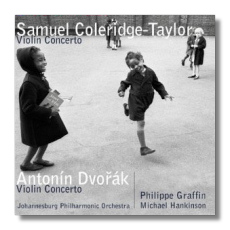
The Internet's Premier Classical Music Source
Related Links
-
Dvořák Reviews
Coleridge-Taylor Reviews - Latest Reviews
- More Reviews
-
By Composer
-
Collections
DVD & Blu-ray
Books
Concert Reviews
Articles/Interviews
Software
Audio
Search Amazon
Recommended Links
Site News
 CD Review
CD Review
Samuel Coleridge-Taylor / Antonín Dvořák

Violin Concertos
- Samuel Coleridge-Taylor: Violin Concerto in G minor, Op. 80
- Antonín Dvořák: Violin Concerto in A minor, Op. 53
Philippe Graffin, violin
Johannesburg Philharmonic Orchestra/Michael Hankinson
Avie AV0044 DDD 62:43
The story of Samuel Coleridge-Taylor is a tragic one. He was born in 1875, the son of an English woman and a doctor from Sierra Leone. He entered the Royal College of Music in 1890 as a violinist, and exited seven years later having proven his mettle in composition and conducting. He then took on various academic positions, and also became a passionate advocate for the advancement of black people. Visiting America, he met wealthy patrons, and also the violinist Maud Powell, and he was encouraged to write a violin concerto. He subsequently wrote one based on spirituals, but the muse suddenly struck him, and he composed a replacement concerto – the one heard here – entirely consisting of original material. Powell was impressed and a première was scheduled. The first set of orchestra parts was lost on the Titanic, and the composer rushed to complete a second set. He was unable to attend the 1912 première, however, and pneumonia claimed him shortly thereafter. On his deathbed, apparently delirious, he conducted an invisible orchestra in an imaginary performance of his concerto. At one time, every self-respecting choral society programmed his cantata Hiawatha's Wedding Feast. Now, like its composer, it is almost forgotten.
At times, Coleridge-Taylor's Violin Concerto sounds as if it could have been written by Antonín Dvořák, another European composer who made a big splash in the United States. There are hints of Elgar as well, and also of older English composers such as Charles Stanford, who taught Coleridge-Taylor composition at the Royal College of Music. I'm afraid I can't report it to be a forgotten masterwork. Some of the melodies are commonplace, as is their scoring, and their development can be lumpy. The writing isn't disastrous – it just isn't very inspired, or inspirational, for that matter. Still, as a piece of musical history, this concerto is well worth hearing, and I am surprised that it has not been recorded until now.
The Dvořák concerto needs no introduction, as the cliché goes. It predates Coleridge-Taylor's concerto by almost 30 years. Another connection between the two works is the violinist who gave them their first American performances: Maud Powell herself!
The Johannesburg Philharmonic Orchestra was formed in 2000, after South Africa's National Symphony Orchestra went under. The symbolism of black and white musicians playing music together is inescapable, particularly when the music is written by a composer of mixed parentage. Graffin is a French violinist, and a former pupil of Josef Gingold. Everyone's performances are serviceable. Graffin's intonation can get a little wild, but stylistically, he's rather strait-laced. The finale of the Dvořák never dances, as the composer surely intended it should.
In spite of my reservations, this is worth investigating for the Coleridge-Taylor, which has many lovely moments, even though it doesn't add up to a convincing whole.
Copyright © 2004, Raymond Tuttle




















